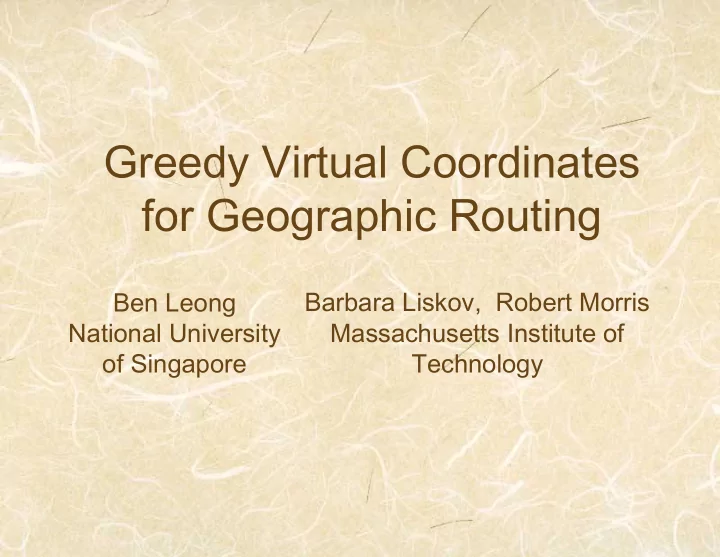

Greedy Virtual Coordinates for Geographic Routing Ben Leong Barbara Liskov, Robert Morris National University Massachusetts Institute of Technology of Singapore
Background • Geographic routing is a promising approach for wireless networks –Each node has an x-y coordinate –Stores little (constant) state per node –Easy to repair
Geographic Routing • Try greedy forwarding • Dead end – switch to guaranteed routing mode – either face or hull tree routing • Whenever possible, switch back to greedy forwarding – because greedy forwarding gives good performance [Xing et al., 2004]
Case for Virtual Coordinates • Not always feasible to have GPS for each node • Virtual coordinates are sometimes better, e.g. sensornet on ship • Physical locations are not required (Rao et al., 2003) • Previous work: good for dense networks • Know: greedy forwarding is efficient • Challenge: can we assign coordinates so that greedy forwarding always works?
Greedy Embedding Spring Coordinates (GSpring) • Start from initial coordinates • Simulate physical spring system with repulsion forces • Incrementally adjust nodes to make topology more convex • Introduce damping and hysteresis to ensure system converges
Determining Initial Coordinates reference node
Determining Initial Coordinates p 1 maximum hops
Determining Initial Coordinates p 1 maximum hops p 2
Determining Initial Coordinates p 1 h p 2 1 h 2 p 3
Determining Initial Coordinates p 4 p 1 h 1 h 2 h 3 p 2 p 3
Determining Initial Coordinates p 6 p 4 p 8 p 1 Each will know of the hop counts between every pair of perimeter nodes p 2 p 7 p 5 p 3
Projection onto Circle p 4 p 6 p 8 p 1 Circumference = spring rest length x total hop count p 2 p 7 p 5 p 3
Projection onto Circle p 4 p 6 p 8 p 1 Arc proportional to hop count p 2 p 7 p 5 p 3
Determining Initial Coordinates • After perimeter nodes determined – matrix of hop counts between them • Determine cyclical ordering of nodes • Project nodes onto a circle • Interpolate for the nodes in between • Some nodes can wait Key idea: stretch network toplogy out in the virtual space like a trampoline!
Spring Relaxation Update Rule • Spring force: = κ × − − × − ( | |) ( ) F l x x u x x ij ij i j i j (Hooke’s Law) • Net force: ∑ = F F i ij ≠ j i • Update rule: α min(| |, ) F i t = + x x F i i i | | F i
Greedy Embedding Graph where given any two distinct nodes s and t , there is a neighbor of s that is closer to t than s . – Greedy forwarding works between any pair of nodes •Here’s a thought: If we pick virtual coordinates such that resulting graph is a greedy embedding, we can achieve good routing performance HOW? ☺
Region of Ownership s
Region of Ownership s
Theorem An embedding of a Euclidean graph is greedy if and only if the region of ownership of every vertex does not contain any other vertices of the graph.
Greedy Embedding Adjustment t s
Greedy Embedding Adjustment t s neighbor of s nearest to t
Greedy Embedding Adjustment t s
Greedy Embedding Update Rule • Repulsion force: = δ × − ( ) R u x x ik i k • Net force: Repulsion forces Spring forces ∑ min(| |, ) R R ∑ ∑ ik max = + ≠ k i F F R ∑ i ij ik | | R ≠ ≠ ik j i k i ≠ k i
Greedy Embedding Spring Coordinates (GSpring) • Once a node has stabilized, use geocast to determine nodes in region of ownership • Use damping and hysteresis to ensure system converges
Performance • Measured Hop Stretch • Topologies –range of network densities (average node degree) –larger networks up to 2,000 nodes • low/high density • obstacles
Actual Physical Coordinates
GSpring Coordinates
Performance • Routing algorithm: GDSTR • Compare with –actual coordinates –NoGeo (Rao et al., 2003) • Measured costs: –iterations required –geocast messages
Performance: Hop Stretch Network Type Physical NoGeo coordinates Sparse UDG Same 30% lower Dense UDG Same 50% lower Obstacle 15% lower 50% lower Can do better than actual coordinates!
Performance over Time
Messaging Costs
Summary • Two key ideas: –Initial coordinates: stretch network out like a trampoline –To make topology more complex: need to move nodes out of each others “regions of ownership”
Future Work • Evaluate GSpring in a real wireless deployment • Study theoretical properties • Region of Ownership generalizable to higher dimensions – Can we do achieve greedy embeddings more easily?
Conclusion • Hard to find greedy embedding with local, distributed algorithm – more greedy improves routing performance • Good for networks with obstacles – converts concave voids into convex ones • “Embedding routing table into coordinate system”
Greedy Forwarding Success
Sparse UDG Networks
Dense UDG Networks
Networks with Obstacles
Recommend
More recommend